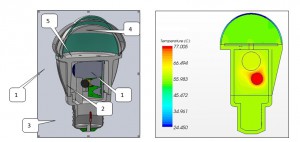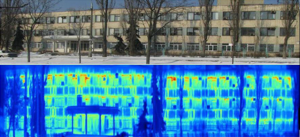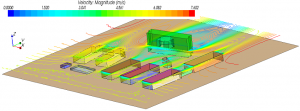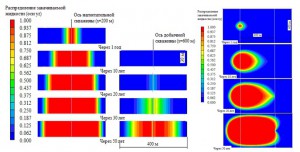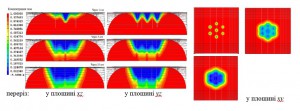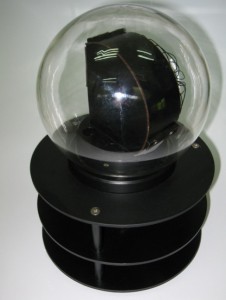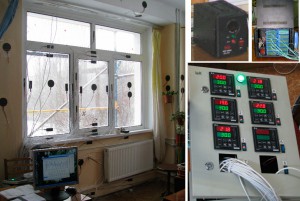Some examples and a brief description of completed projects or projects are being executed
Scientific and organizational activities of the department:
Development of the project of the National heat supply strategy of settlements of Ukraine (till 2030)
The work is carried out jointly with other departments of IET and other institutes of the National Academy of Sciences of Ukraine in accordance with the Resolution of the Cabinet of Ministers of Ukraine No. 465 dated May 7, 2008 “On the Establishment of an Interdepartmental Working Group for the Development of the National Heating Supply Strategy” and in accordance with the Resolution of the Presidium of the National Academy of Sciences # 37 of February 16, 2011. pp. “Results and problems of modernization of municipal heat and power engineering in Ukraine”. The work is carried out within the framework of the target integrated multidisciplinary program of scientific researches of the National Academy of Sciences of Ukraine on problems of sustainable development, rational use of nature and preservation of the environment (2010-2014).
The purpose of the National Heating Strategy of Ukraine is to create and implement an effective policy of reliable, high-quality and socially accessible (technically and economically justified, while complying with environmental requirements) provision of population and fiscal-social sphere with heat, hot water and air conditioning in order to create appropriate comfortable conditions. for living and working and ensuring Ukraine’s energy security on the basis of sustainable development.
The main tasks of the Ukrainian heat supply strategy are:
- Improvement of the existing and creation of a new legal and regulatory framework and regulatory and technical basis for the effective implementation of the Ukrainian heating policy. Implementation of modern norms and standards in the field of public construction and reconstruction of housing stock;
- Improvement of the existing and the formation and development of a new management system in the field of heat supply in Ukraine. Creation on a market-based basis of an effective competitive system of interaction of all participants in the field of heat supply; gradual demonopolization of the natural heat supply monopoly; introduction of mechanisms of state regulation and economic stimulation of energy efficiency in the field of heat supply;
- Improvement and development of the policy of prices and tariffs in the field of heat supply;
- Technological and technological modernization of the heating sector. Reducing the impact of the pollution of the heating system on the environment; modernization and development of heat supply schemes of settlements on the basis of general plans for their development;
- Creation of a favorable investment climate, establishment of an effective financial and credit system based on market principles and sustainable development. Implementation of system of targeted subsidies, subventions and subsidies;
- Use of experience and achievements of academic and branch energy science, use of new innovative technologies of heat supply, use of promising fuels and secondary energy resources, implementation of energy saving and energy efficiency policies; development and implementation of policies for the modernization of existing and building new ecological and energy efficient buildings;
- Development and implementation of a regional heat supply policy. Creation of annual energy balances;
- Creation of a system of consulting, monitoring, energy audit and inspection in the field of heat supply;
- International integration in the field of heating. Use of advanced world experience in the field of thermal power engineering. Adaptation to the European policy of effective heat supply. Using the Kyoto Protocol mechanisms.
- Development of the energy culture of the population in the sphere of energy saving. Propaganda of energy-economic life style of man and the whole population;
- Establishing a system for managing the heat supply sector, defining indicators and indicators for the implementation, monitoring, audit, control and adjustment of the National Heating Policy of Ukraine.
Expected results of the implementation of the National Heating Policy Strategy of Ukraine:
- the creation of a number of laws of Ukraine and the legal and regulatory framework for the effective functioning of the environmentally sound system of heat supply on a market basis and on the basis of sustainable development;
- to achieve, within the final term, the implementation of the National Heating Strategy for the consumption of heat by the individual housing sector, housing and communal sector and the social and fiscal area in the range of 1.5 … 1.6 times higher than in 2010.
- Implementation of the system of energy efficiency and energy saving in the field of new construction, reconstruction of the existing administrative and housing stock and in the system of heating. Achievement of the final implementation of the National Heating Strategy for the Conservation of Primary Energy Resources by Implementation of Structural and Technological Energy Saving Measures at 28 … 30% (up to 27 mln tons of conventional fuel, mainly natural gas).
- diversification of primary fuel, use of secondary energy resources, renewable and non-traditional energy types; diversification of suppliers of primary fuel, diversification of heat suppliers; avoid dependence on fuel imports; promotion of energy security of the country; On the basis of the implementation of these measures, the reduction of the use of fossil primary energy resources by half (as compared to 2010) in 2030, the achievement of the implementation of the National Heat Supply Strategy in the heat supply system of Ukraine by the end of the year, the annual utilization of fossil primary energy resources to 25 … 28 million t of conventional fuel.
- high-quality, reliable, safe and accessible for payment by the customer of heat supply in settlements of Ukraine;
- creation of comfortable conditions for living and work of the population of Ukraine; in this regard, the absence of social tension in society;
Regional program of modernization of municipal heat and power engineering – an innovative basis for technical and technological updating of municipal heating systems
The work is carried out within the framework of the Resolution of the Cabinet of Ministers of Ukraine No. 401 dated April 2, 2009 “On Approval of the Procedure for the Development of Regional Programs for the Modernization of Heat Supply Systems” and according to the decisions of regional or city councils of deputies.
The problem of development of the scientific-industrial sphere of municipal heat and power engineering is considered as the subject of fundamental and applied research. Together with other ITT departments of the National Academy of Sciences of Ukraine, the principle statement on the basic role of five-year regional programs for modernization of municipal heat and power engineering as an innovative basis for technological modernization of heat supply in settlements of Ukraine is formulated. The main results of research on the use of energy-efficient technologies and equipment for modernization of municipal heat and power engineering of Ukraine are presented. On the basis of a number of regional programs, a draft state target program for the comprehensive modernization of communal heat power engineering in Ukraine for 2010-2014 has been developed. The basis of the program is the innovative energy efficiency measures, as well as the general recommendations of the regional programs of modernization of municipal heat and power in 23 regions of Ukraine and the cities of Kyiv, Kharkiv and Sevastopol, based on the positive experience of pilot regional programs, successfully implemented in the Donetsk region and in Kharkiv.
The basic principles and priorities of the regional program are:
- replacement and savings in housing and communal services enterprises, mainly natural gas, by 30% (15% + 15%) in the first 5 years;
- use of domestic equipment and energy-efficient technologies, only in the absence of foreign ones;
- scientific and technological support of the program by the national energy science.
The payback period of the main activities of the typical regional program is up to 3 years, and even taking into account relatively long-term measures to replace the heating networks and thermo-modernization of buildings, the average payback period of the program does not exceed 5 years.
Development of the concept and project of the state target economic program of modernization of municipal heat and power engineering of Ukraine for 2010-2014.
The work was carried out at the request of the Ministry of Housing and Communal Services of Ukraine.
The purpose of the program is to increase the economic and energy efficiency and reliability of the functioning of the municipal heat and power industry in Ukraine through its comprehensive modernization on the basis of sustainable innovation development.
Implementation of the program will lead to the following results:
- achieve the final implementation of the program of heat energy consumption by the individual housing sector, housing and communal sector and the social and fiscal area in the range of 1,2 … 1,3 times as compared to 2010
- implementation of the system of energy efficiency and energy saving in the field of new construction, reconstruction of the existing administrative and housing stock and in the system of heating. Achievements in the final period of implementation of the program of annual primary energy saving in the communal sphere due to the introduction of structural and technological energy saving measures at 28 … 30% (annually up to 4.5 million tons of conditional fuel, mainly natural gas, corresponding to its equivalent volumes in 3 , 8 billion m3)).
- diversification of primary fuel, use of secondary energy resources, renewable and non-traditional energy types; diversification of suppliers of primary fuel, diversification of heat suppliers; avoid dependence on fuel imports; promoting energy security of the country. On the basis of the implementation of the program activities, it is expected that in 2014 the use of fossil primary energy resources will be reduced by almost a third (compared with 2010).
Development of the project of the target complex program of scientific researches of the National Academy of Science of Ukraine “Scientific and technical bases of modernization of municipal heat and power engineering in Ukraine”
The work was carried out in pursuance of the Resolution of the Presidium of the National Academy of Sciences №37 of February 16, 2011 “Results and problems of the modernization of municipal heat and power engineering in Ukraine”.
The implementation of the program on the basis of an energy-saving model of the development of municipal heat and power engineering will allow, based on innovative technologies and equipment, to: – ensure the sustainable, efficient and reliable operation of communal heat power engineering on an innovative basis and attract investments, especially private ones, – improve the economic situation of utility companies; fuel and energy resources – to improve the environmental condition of the environment – to increase the level and quality of services t plopostachannya to the population – decrease in the large-scale implementation of the program development level of energy consumption in municipal power system about 1.5 million tons. per year and emissions of greenhouse gases to 3.3 million tons per year; – more widely involve local fuels (peat, wood, biomass, etc.) and renewable energy sources in the fuel and energy balance of municipal heat and power generation; – to create new local power generating capacities that improve the situation with available shunting capacities. – reduce emissions of harmful substances (NOx, SO2, CO, solids, etc.) to the environment, – reduce emissions of gases with the greenhouse effect (CO2, CH4, N2O ) – reduce the thermal pollution of the environment – involve the mechanisms of the Kyoto Protocol for the comprehensive modernization of the municipal heat and power industry of Ukraine – make the municipal heat energy sector economically attractive and involve investment capital in its development – increase energy security state.
Development of the concept of the state program of modernization of communal heat power engineering in Ukraine for 2014-2015
The work was carried out in 2013 under the operational order of the Ministry of Regional Development of Ukraine as an integral part of the state program of intensifying the development of the Ukrainian economy for 2013-2014.
The purpose of the program is to increase the economic and energy efficiency and reliability of the functioning of the municipal heat and power industry in Ukraine through its comprehensive modernization on the basis of sustainable innovation development.
The realization of this goal requires the solution of a number of interrelated tasks aimed at saving at the enterprises of housing and communal services of energy resources, including for saving and replacing natural gas up to 50% (approximately 25% + 25%) with a rather short payback period (up to 4-5 years) of the proposed technological and technical measures with the use of mainly domestic equipment and modern energy-efficient technologies.
The program forms and defines the role and place of municipal heat and power in the socio-economic life of the country, as well as the conditions in which the state and enterprises of various forms of ownership can effectively contribute to the development of municipal heat and power.
The program is based on regional programs for the modernization of municipal heat and power.
Report on the work “Improving the energy efficiency of municipal heat and power in Kharkiv at the expense of its technical and technological modernization (in the period of 2004-2012)”
The purpose of this work, carried out jointly with the other departments, was to identify ways, technical solutions and, most importantly, specific technical and technological innovative energy efficient measures for significant reduction of natural gas consumption (at least 30% of the base level of 2008 р.), which is burned at the heat power plants and boiler houses of the city of Kharkiv.
The main results of the implementation of measures to improve the energy efficiency of municipal heat supply in Kharkiv by the municipal enterprise “Kharkivski teplovi merezhi” in the period 2004-2012:
- Number of replaced old boilers (types NIISTU-5, Universal, Nadtochiya, etc.) – 150 pcs.
- Number of installed new equipment (units): 222 new boilers, 211 burners, 58 ITS, 2 heat utilizers, 131 frequency controllers, 415 installed devices and diagnostic systems.
- Improved heat supply scheme of Kharkiv city due to loading of Kharkiv CHP-5.
- Total energy savings achieved:
- reduction of consumption of natural gas – 870.9 million m3,
- decrease in consumption of other fuel, 2.8 thousand tons of fuel equivalent,
- Electricity savings, 139.7 thousand MWh.
Scientific, scientific and technical activities of the department:
Energy-efficient passive type building
The purpose of this project is to create an experimental energy-efficient passive type building (with annual consumption of thermal energy for heating needs not more than 15 kWh / m2) as a full-scale scientific-technical and technological thermophysical laboratory with a useful area of up to 300 m2 in the IET of the National Academy of Sciences of Ukraine.
When creating an experimental energy-efficient passive type building, energy-efficient, socially accessible, domestic building materials and technologies that meet modern requirements were used. The basic conceptual principles of building passive houses are taken into account: compactness, maximum tightness of enclosing structures, qualitative insulation, absence of bridges of cold, correct geometry of the house, orientation on the sides of the world. New technologies of multilayered fencing constructions, sealed multi-chamber plastic windows with low-emission glass and multi-chamber profiles of window frame frames have been used. Each external wall of each room of the house is constructed of different building materials in order to study their energy-saving properties. The integrated heat supply solutions are implemented, namely, an autonomous polyvalent heat pump system using the soil heat, insolation of solar energy and recuperative ventilation.
Much attention was paid to the creation of a branched automated measuring system, which includes various automated continuous measurements of temperature fields, heat fluxes, humidity, pressure, and external climatic parameters. Sensors and gauges are located in building constructions, indoors, in the surrounding ground and in the air. This will allow testing, testing and research of building materials and energy saving constructions, modern technologies of energy and heat supply with the use of renewable environmentally friendly sources of energy of the sun, ground, air and develop recommendations for the design and selection of building materials and building structures for the serial construction of passive houses in conditions of Ukraine.
а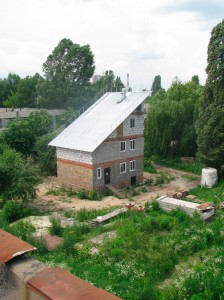 |
б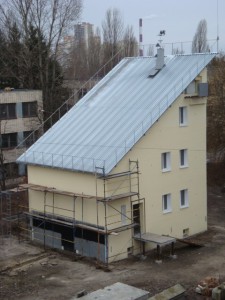 |
The appearance of an experimental passive type building at the stage of its construction before (a) and after (b) thermo-modernization.
Experimental building of “zero energy” type
The purpose of the project is to develop and implement a complex combined power supply system for an experimental passive house and to progressively develop a “passive type” home to the “zero energy” building. An independent and autonomous functioning of the house is envisaged without connection to the centralized resource supply networks. Its energy supply is realized on the basis of the use of alternative and renewable energy sources.
Characteristics: In Ukraine, as in the CIS countries, and even in many countries of Eastern Europe, there are no such buildings. The climate of Kyiv creates some difficulties for building “zero energy”: long, cold winters, many cloudy days, low wind speeds. However, due to modern building technologies, new building materials, active scientific and engineering work, construction of such buildings is possible.
It is natural to test the effectiveness of the proposed solutions initially at the experimental “zero energy” building, where an autonomous polyvalent heat pump system of energy supply is implemented. This system utilizes the renewable heat of the ground, the heat of solar radiation and the recovery in the system of inflow and exhaust ventilation. For electricity, solar energy (photoelectric elements) and wind energy (wind turbines) are used. Solar thermal collectors and photovoltaic cells are located on a single-skinned roof on the south side of the house. The heating of the experimental building is based on accumulation of low-temperature and medium-temperature heat pump heating systems.
Result: an experimental “zero energy” building (energy autonomous) with an area of 300 m2 will be created on the IET of the National Academy of Sciences of Ukraine. Experimental “zero energy” building – a convenient full-scale thermophysical laboratory researching the energy efficiency of building structures.
Ground heat accumulators
For the study of heat transfer processes in the system “heat exchanger-ground” at the injection, accumulation and extraction of heat in the territory of IET of the National Academy of Sciences of Ukraine (Bulakhovsky St., 2) a landfill of ground heat exchangers of different types and different configurations was created.
Polygon includes:
- a group of ground heat exchangers-accumulators consisting of vertical wells of a special arrangement with a depth of up to 25 m (hexagon with an axial well and a direct row of 5 wells with single, double and U-shaped heat exchangers);
- heat exchanger “tube in a pipe” type;
- heat exchanger in the water intake well;
- heat exchanger in concrete-pile;
- horizontal multi-loop pipe heat exchanger;
- a system of multi-channel water and air pipe heat exchangers;
- combined heat exchanger for water or air from several horizontal registers.
For example, a ground-level horizontal heat exchanger of shallow deposits removes the heat accumulated in the upper layers of the soil (depth 1-2 m) as a result of solar radiation (direct heating, precipitation, heat of air), and is a coil consisting of five loops. The total area of the heat exchanger is 240 m2. Made of polyethylene pipes in diameter of 32 mm, which are designed for pressure of 6 bar. Pipes are laid in a trench with loops in a step of 1 m. As a coolant an aqueous solution based on propylene glycol, which circulates through pipes, takes away the warmth of a soil, is used. Measurement of soil temperature, coolant is carried out by a control and measuring system, followed by computer processing of the obtained values.
The method of creating a seasonal high-potential heat accumulator in the soil mass is developed, which is based on the analysis of the joint work of the aggregate of ground heat exchangers of the pipe type. The experimental ground accumulator consists of seven vertical wells with a depth of 20.5 m, located in the form of a correct hexagon. U-shaped heat exchangers are installed in the wells: at the hexagon heights – two U-shaped heat exchangers of the same type with the same thermal load, in the center – three U-shaped heat exchangers.Heat exchangers are connected in series. To measure and control the temperature of the soil, additional drill wells of one-way direction with a depth of 25 m are drilled. They have U-shaped heat exchangers, which are equipped with temperature sensors along the length. In the summer, the heat of solar radiation, transferred to the intermediate coolant, circulating in the acumulator, heats the soil mass, and in the heating season it is removed and used in the evaporator of the heat pump.
Block of ground heat exchangers of a well-type (top view).
The system of heat supply and air conditioning of premises using a heat pump of ground-liquid type
The IET NAS of Ukraine actively develops the scientific and technical center of heat pump technology, which develops, and then undergoes testing, combined polyvalent heat and air conditioning systems for premises of various uses. The team of the department developed a number of original hydraulic circuits and, according to its original method, carried out engineering calculations of the thermal engineering parameters of systems that allow the use of the potential of regenerative heat of the soil with the help of a horizontal multi-level ground collector. Such a design allows for the commissioning of sections of a pipeline of different lengths, thereby changing the specific thermal load. In the cold period of the year, the heat pump directs heat carrier with the necessary temperature potential to low temperature heating systems (simultaneously or individually) such as the water-heated floor of a separate laboratory room and air heat exchangers (fancoils) located in two rooms. The layout of the water circuit in the floor is bifilar, directed towards the supply and return pipes. In the warm period of the year, the scheme involves the passive air conditioning in both rooms (simultaneously or alone) by means of a hydraulic isolation of contours of air heat exchangers and a ground collector. In this case, there is a compensation of the thermal state of the soil that has changed during the heating period. The installation in each of the hydraulic circuits of heat meters of various designs allows you to perform the necessary balance measurements of the amount of heat transmitted. The automated system of experimental data analysis involves measuring the temperature and specific heat fluxes using thermoelectric converters and secondary digital devices with subsequent archiving of values. In the laboratory room in real time with the help of special software, data are obtained in the characteristic places: along with the ground collector at different depths and between different layers of warm floor, as well as along the vertical line from floor to ceiling. The system of heat supply and air conditioning of various premises using a heat pump type ground-liquid has proved itself as an effective, economical and ecological technical solution with a high degree of reliability and comfort regarding the climate of the premises in accordance with sanitary and hygienic requirements.
The method of solving the problems of non-stationary heat-mass conductivity under variable external conditions
A closed system of algebraic and ordinary differential equations is proposed, which allows simple and high accuracy to solve non-stationary problems of thermal conductivity and diffusion extraction of matter from solid bodies of a standard form – plates, cylinder, balls – under varying external conditions. The method is based on a single universal dependence, which describes with high accuracy the distribution of temperatures and concentrations of matter in the above-mentioned bodies, and on the equations that determine the changes in the characteristics that are included in this dependence, in time or in space when moving the bodies.
А. И. Накорчевский. Сопряженные задачи нестационарной тепломассопроводности при переменных внешних условиях. ИФЖ, Т.72, №4, 1999, С. 782-791.
Method of calculation of heat loss through external enclosures of buildings
The method of calculating non-stationary heat transfer through elements of external fencing of buildings (walls, composite walls, windows) is developed, taking into account the annual effect on solar insolation. It is established that under this approach, estimated heat losses through the fence of buildings in the middle latitudes of the northern hemisphere of the Earth are significantly less (tens of percent) calculated without taking into account the effect of the Sun. It is proposed to use excessive summer heat. The application of the technique allows more accurately determine the energy consumption for heating residential and public buildings.
Thermophysical modeling of air-temperature mode of premises
In order to determine the optimal level of heat supply that would provide the proper air-temperature regime in the premises of the building, it is necessary to solve the problem of heat transfer from the heating device to the ambient air environment, taking into account the circulation of heated air in the rooms, convective heat flows carried by the internal air currents, heat conductivity through the ceiling and walls, solar radiation, convective heat transfer from the surfaces of the fence, etc. The department developed a thermophysical model for studying the air-temperature regime of premises and facilities in general, which takes into account all of the above factors. Verification calculations for the indicated model for control rooms have shown satisfactory agreement with their own experimental data on the temperature and air conditions of the premises.
 |
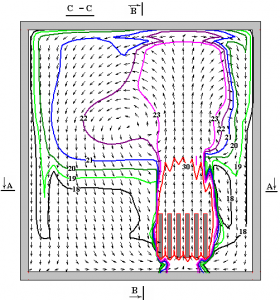 |
Temperature fields and velocity vectors of air flow in different sections of the room with a cast-iron radiator
Investigation of thermal conductive properties of composite materials on the basis of aluminum-oxide ceramics and calculation of effective heat transfer from powerful LEDs
A 3D CFD model of heat transfer and thermal dissipation in the cooling system of powerful LED lamps was developed, taking into account the thermophysical properties of new composite materials, and appropriate numerical studies have been carried out. The obtained temperature fields in all constructive parts of a powerful LED lamp for different positions of the lamp in space under standard operating conditions and the efficiency of the cooling system made from a new composite material – thermal conductivity ceramics has been proved.
Components of LED lamps. 1 – body of the cooling system with a developed fin surface, 2 – electronic control system, 3 – socle, 4 – light diffuser, 5 – LED board.
Investigation of thermohydrodynamic instability in elements of heat and power equipment
The new mechanisms of heat-hydrodynamic instability of the heat carrier flow, in particular, longitudinal self-oscillations caused by heat transfer or transformation of the mechanical energy of rotation of the blade drive supercharger into the pressure of the stream, are proposed and investigated. Based on this, effective methods for controlling the amplitude of self-oscillations excited in potentially unstable elements of different heat and power equipment : generators of thermoacoustic self-oscillations, furnaces burning chambers, regenerative air heaters of blast furnaces to it, combustion chambers of liquid jet engines, fuel delivery systems, air supply systems, including lamellar superchargers, steam generator steam generators, in dynamic systems with complex geometry, in particular in cylindrically thickly perforated systems of the generalized Kuett cell type.
Thermal imaging inspection of buildings
An important role in increasing the energy efficiency of structures is the use of contactless (thermal imaging, pyrometric) infra-red methods of control and diagnostics. Thermal imaging control of the quality of building structures, ventilation and heating systems allows you to identify areas of condensation of moisture and defects of building structures, heat loss from the seams of the house, violations in heating systems and ventilation of buildings. Carrying out an external heat-thermal survey gives an opportunity to estimate the total heat loss of buildings, to identify places with the highest level of heat loss, to analyze the efficiency and quality of the use of building solutions in its construction. The internal thermal visual inspection is more detailed and it is intended for analysis of thermal mode of separate premises, and also installation of defects of heating and ventilation.
Southern facade of the building №1 of IETof NAS of Ukraine (Bulakhovsky str., 2). Optical and thermal imaging photo.
Calculation of winding flow of single buildings and their complexes
The calculation of wind currents within the boundaries of urban development is necessary when designing new and operating existing microdistricts. The exact definition of wind loads on tall buildings and structures plays an important role in creating effective and safe construction structures. The problem of aeration of the territory, the spread of harmful gaseous emissions, dust and aerosols in urban construction, and the effectiveness of the systems of natural ventilation of buildings, heat exchange on the surfaces of buildings, etc., are also closely related to this problem.
In the department there is accumulated experience in solving tasks connected with wind flow of individual structures and their complexes. The regularities of distribution of coefficients of heat transfer on the surfaces of structures are studied. These data are used to study the heat loss through the building envelope. Solutions such tasks are carried out both with the help of known universal computer CFD-packages, and with the use of its own software.
The field of speeds at an altitude of 10 m when flowed through the air flow of a complex of buildings on the territory of IET NAS of Ukraine on the Bulakhovsky str., 2.
Developing original IHP and creating algorithms for managing them
The algorithm of control of an individual heating point (IHP) is developed, which allows to provide the mode of intermittent heating of the working premises in the winter period of the year with optimal control parameters. Intermittent heating is to maintain the temperature of the heating system at a certain level, which provides the necessary temperature mode of the room, only during working hours. During off-hours, the temperature of the radiator is reduced, which leads to a decrease in heat in the room and a decrease in air temperature. A few hours before the beginning of the working day, the temperature of the heating system is set above the level, characteristic of the working time, so that before it the temperature conditions in the room were in accordance with the norm. The control parameters of this mode are: the time to switch to the heating mode of the heating system, the time to go to the standard mode, as well as the minimum and maximum values of the temperature of the heating device. The following control parameters are optimal, which ensure maximum thermal energy savings, provided that the average temperature is maintained at working hours at the required level. The work of an individual thermal unit with optimal control parameters allows to reduce the heat consumption of the premises by 5 … 7%.
In accordance with the proposed control algorithm for the heat supply system of the building number 1 of IET of NASU on the Bulakhovsky str., 2 created two IHP of the original design:
- An experimental IHP with the capacity of 300 kW with electric heat generation in the conditions of a preferential night tariff for electricity is developed and implemented, in order to provide optimal mode of operation of the heating system of the administrative building IET of the National Academy of Sciences of Ukraine, the automated distribution of the heat carrier and the regulation of its parameters, as well as instrument accounting consumption of heat.
- An experimental IHP with a hydraulic arrow with a heat output of 250 kW for heat supply and air conditioning of the first building of IET of the National Academy of Sciences of Ukraine was created.
Thermophysical modeling of processes of hydrodynamics and heat exchange in geothermal circulating systems
The task of calculating geothermal systems with gas dissolved in them is to determine the mode of filtration of the coolant to provide a given thermal efficiency of the system during the entire life of the operation, reaching 40…50 years old.
When calculating and designing geothermal circulation systems using gas-saturated water, it has to be faced with the fact that, when pumped into the formation of used, and therefore degassed and cooled water, the gas content in the extracted water begins to decrease. There is a need to estimate the rate of distribution of the fluid to be pumped in the aquifer and the period of time through which the fluid to be pumped up will reach the lift well, and the use of dissolved gas will gradually cease. This fact determines the term of operation of the generator’s part of the ground complex. Operating modes of the thermal part of the installation depend on the dynamics of the temperature field in the underground reservoir when it is pumped into a cooled liquid.
The thermophysical model of the heat carrier movement in a long vertical well, surrounded by mountain ranges, and its solution with the help of the application software package Rhoenics is proposed. The model allows to conduct engineering heat-hydrodynamic calculations of wells, which lie in different geological conditions, with different debits, at different depths of occurrence of the aquifer, taking into account different modes of operation. The engineering nomograms are calculated for determining the change in the temperature of the coolant along the depth of the well depending on the depth of the well, the flow rate, the reservoir temperature, the operating mode.
The thermophysical filtration model describing the thermohydrodynamic processes in an underground penetrating collector with the injection of a cold coolant is proposed. Three-dimensional non-stationary fields of temperature and concentrations of the pumped liquid and natural liquids are calculated in the system of permeable collector – a rock massif (example – in Fig.). The changes in the parameters of the filtration flow, the cooling kinetics of the permeable collector and the surrounding rock mass, the dynamics of the distribution of the cold coolant, pumped into the collector, are analyzed.
The distribution of the concentration of water pumped into the formation, in the planes: a – y-z, b – x-y.
Biogas filtration processes in the porous body of the solid household waste (SHW) landfill
The model of processes of gas formation, hydrodynamics and biogas filtration in a porous body of a solid household waste (SUW) landfill has been developed. Considered the conjugate task of dynamics of biogas flow in wells and in groups of wells. The concentration of gas in the body of the landfill was calculated with the constant operation of wells during the time (the period of exploitation of wells was up to 10 years), with constant flow rate and different pressure of selection. The calculation of the polygon was carried out taking into account conditions close to the real ones. The fields of distribution of pressure and concentration of biogas in the body of the landfill have been obtained for 10 years. The results of calculations give an opportunity to estimate the time of effective operation of biogas extraction systems at landfills.
Changing the concentration of gas in the body of the landfill at a pressure pumping: Pc = 2360 Pa, after 1, 5 and 10 years.
Thermo-modernization of buildings. Optimal choice of warming options
Technical solutions for the thermo-modernization of residential buildings and public buildings should be based on a deep understanding of the complex interconnected thermophysical processes that take place in them. This primarily concerns the choice of heat-shielding coatings and translucent structures with optimal thermal characteristics, which in addition must be environmentally friendly and fire-proof. Due to the fact that in the market of heat-insulating materials and translucent structures their various variants are offered, it is necessary to have reliable data about their behavior in real weather conditions under long-term operation. In order to solve this issue, poly-variant thermo-modernization of external fencing constructions of the northern part of the administrative building of the IET of NASU ( multi-variant energy efficient windows and insulation of the facades) was carried out, and a measuring complex was developed for the study of heat loss through them. This project allows establishing the optimal variant for thermo-modernization of buildings.
The view of the thermo-modernized part of the facade, a photo and a thermal imaging of the two windows and the walls adjacent to them.
Measurement of solar radiation
Jointly with the Department of Thermometry of IET of the National Academy of Sciences of Ukraine, two devices (SR-U1 and SR-M1 pyranometers), which belong to the actinometric group, are created and serve to solve the problems associated with long-term continuous monitoring of the radiation properties of the atmosphere and accumulation of income data solar radiation on the surface of the solar collectors and the surface of the external enclosing structures of buildings. They measure the density of total solar radiation entering the planes with an angle of inclination to the horizon from 0 ° to 90 ° with a step of 10 ° (a pyranometer SR-U1) and a plane parallel to the external fencing structures of the building (pyrameter SR-M1). For the purpose of long-term accumulation of data on radiation properties of the atmosphere, these devices were installed on the roof of the building №1 of IET of the National Academy of Sciences of Ukraine, st. Bulakhovskogo, 2. From October 1, 2012, the collection, processing and systematization of the received data on solar radiation is carried out for the city of Kyiv.
Pyranometer SR-U1.
Experimental measurement of heat loss of buildings
The TBET Department of the National Academy of Sciences of Ukraine pays great attention to obtaining, archiving and processing of experimental data. For these purposes, all stationary laboratory installations and stands are equipped with PC-based measuring complexes that allow for continuous monitoring and rapid processing of measured parameters in real time with long-term experiments (continuously, over the years, periodicity of unit measurements – from seconds to hours). For mobile thermal measurements, in the course of various experiments, a portable measuring complex was created that allows simultaneous monitoring and storage of data from 48 heat sensor sensors and 48 temperature sensors (TCM-50, TSP-100), or from 48 combined heat flow sensors with built-in temperature sensor TSP-100 (heat exchangers designed and manufactured by the Department of Thermometry of IET of the National Academy of Sciences of Ukraine). As additional equipment for mobile measurements in the department there are high-precision digital humidity meters, digital thermoanemometer, digital pyrometer and thermal imager. This set of equipment allows conducting a comprehensive examination of the thermal characteristics of the enclosing constructions of buildings and measuring the temperature of air inside and outside the premises, as well as the external and internal surfaces of the external enclosing structure of buildings, the direction and speed of air flow, the humidity of air inside and outside the premises, the humidity of thermal insulation materials, used for thermo-modernization or thermal building of buildings, etc.
Research efficiency of windows in real conditions of use.
Problem of discrete impulse input and transformation of energy:
Investigation of rotating pulsating flows and the creation of rotary-pulsating apparatus
In the framework of the DIIE methodology, namely, on the basis of the study of the hydrodynamics of heat and mass transfer and the effects of crushing in the rotating pulsating flows of dispersed liquid media, a method for calculating the dynamic characteristics of cylindrical rotary-pulsating apparatus with different variants of the layout of the working organs is developed. These devices, operating on the principle of discrete-pulse input of energy, are intended for the production of fine dispersed emulsions and homogeneous mixtures
Due to a number of important advantages that distinguish them from traditional propeller mixers, such devices have been widely used in the chemical, food, pharmaceutical, processing and other industries and agriculture. The developed method allows us to calculate the velocity fields that periodically change in time, pressure and temperature in the working area of the apparatus (the duration of the period is ~0.3-10-3 s), the moments of the hydrodynamic resistance forces acting on the rotor, as well as the size of the disperse particles emulsion after it is processed in the device.
The method of optimization of structural characteristics and mode parameters of the apparatus is constructed depending on the required productivity, quantity of consumed energy and characteristics of the finished product.
Intensifying effect of adiabatically flowing streams
A series of studies of adiabatically flowing flows in heterogeneous systems is presented. Fused on the surface of the phase separation of the microtubule, with their subsequent collapse, have a powerful mechanical effect on the dispersion. As a result, processes of dispersion and interphase heat transfer are intensified.
А. А. Долинский, Б. И. Басок, А. И. Накорчевский. Адиабатически вскипающие потоки. Теория, эксперимент, технологическое использование. Киев. Наукова думка, 2001, 208 с.
А. И. Накорчевский, Б. И. Басок. Гидродинамика и тепломассоперенос в гетерогенных системах и пульсирующих потоках. Киев. Наукова думка,2001, 348 с.
Computer packages of the department
- Software package for the solution of the problems of non-stationary heat and mass conductivity on the basis of experimental and analytical approaches (Doctor of Technical Sciences, Nokrchevsky A.I.).
- Use of modern commercial packages (Phenix, Ansys-Fluent).
- The original software package for the solution of the problems of hydrodynamics and heat transfer (Doctor of Technical Sciences Davenenko B.V.).
Experimental stands:
- Experimental passive-type energy efficient building. (IET, Bulakhovsky St. 2).
- Polygon (booth for research) of energy-efficient window constructions in real climatic conditions of operation of the building for a long period of time (the first building, the 2d floor, north side).
- Polygon of heat-insulating coatings for varied thermorenovation of building envelope structures (the first building, the 2d floor, north side).
- Experimental heat pump installation with horizontal soil heat exchanger for autonomous heat supply and air conditioning (1 corp.).
- Polygon of experimental vertical well-type heat exchangers.
- Experimental heat supply system with autonomous use of the air-liquid heat pump (the first building, exhibition).
- Experimental individual heat station with built-in electric boilers for automated control of the building’s heat supply (the first building of the IET of NASU, Bulakhovsky St. 2).
- Experimental installation of individual heat point with hydraulic arrow for automatic control of buildings heat supply (the first building of the IET of NASU, Bulakhovsky St. 2).
- Experimental wind turbine for power supply of the “0” energy building.
- Complex of methods and set of portable measuring devices and equipment for energy audit of buildings and objects of energy.
- Automated portable weather station to determine climate parameters.
- Experimental block of 2 pyranometers of the original design to determine the intensity of solar insolation.
- A “0-energy” home air-conditioning system based on the use of natural and stored ground heat. Polygon of various variants of low-temperature “water floor” heat exchangers.
- The system of backup heating of the house “0-energy” based on the use of solid fuel boiler equipped with a pellet burner.
- System of reserve air heating of the house “0-energy” based on the use of solid fuel furnace, equipped with a system of air pipelines
- Technological installations of rotary-pulsation type for realization of processes of dispersion, grinding and homogenization of heterogeneous dispersed liquid media.
- System of autonomous power supply from photovoltaic cells with batteries.
- Energy efficient ventilation system based on a recuperative vent with air heating from a heat pump.
- System of thermal protection of building based on ground heat exchangers.
- Unit for measuring thermal characteristics of external enclosure structures and microclimate parameters of building premises
- Experimental pellet burner up to 15 kW.


